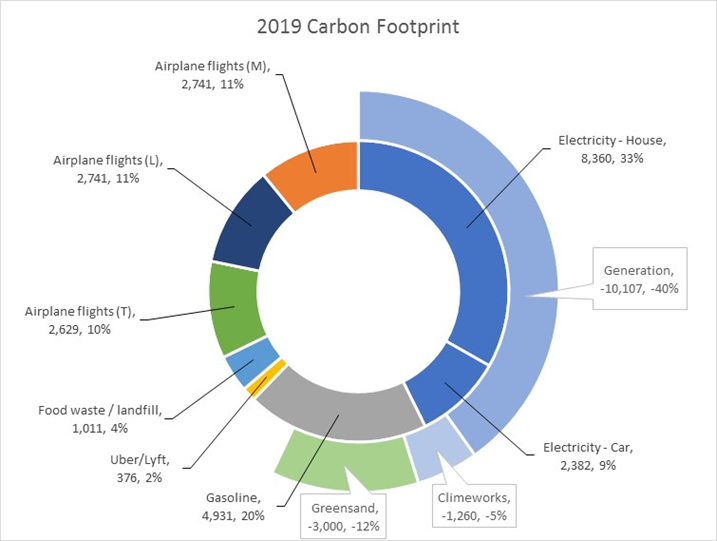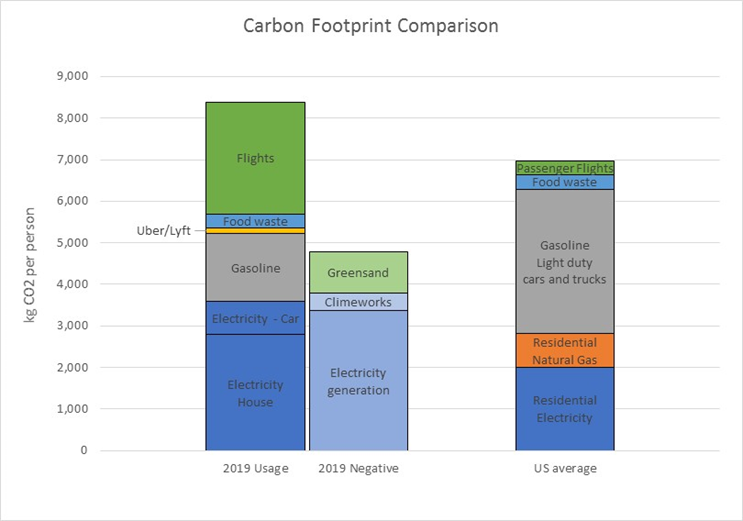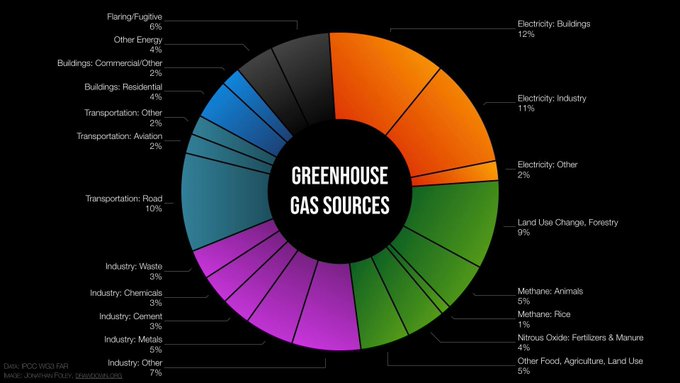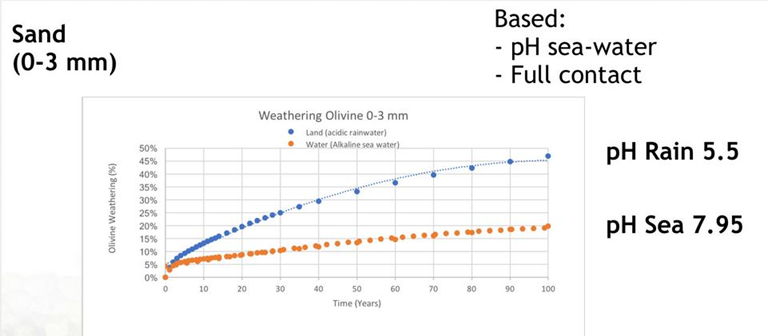Time to write up something I’ve been meaning to get to for a while. This is my family’s carbon footprint for last year. 2020 is going to look great because we’re not flying and we’re barely driving, but what’s shown is more typical.
A thread, with thoughts on how we get to zero.
A thread, with thoughts on how we get to zero.
I’m not interested in arguing about individual action vs. systemic change. We can’t get there with individual action alone. That’s why I volunteer with @citizensclimate. But I think those of us who want to see a zero-emissions economy need to show what that would look like.
2/
2/
Here’s what it looks like compared to the US average for the same categories. It's per-capita emissions in both cases. These are only the things I directly control – electricity, driving, space heating, flying, etc. I'm including food waste, because I could be composting.
3/
3/
The actual US per capita total is 20.3 tons / year. The rest is from the business and industries you buy things from. I view emissions as either easy (electricity, heating, driving) or hard (industrial heat, cement, airplanes). For the US, the easy stuff is ~2/3 of the total.
4/
4/
This is an incredibly useful graphic to have in mind. From @GlobalEcoGuy at @ProjectDrawdown. This is for world emissions. The US is similar, but vehicle emissions are higher and instead of deforestation we have forest sequestration.
5/
5/
My house generates enough to cover everything the house uses plus one EV. That includes heat and hot water. We have no natural gas connection. All the details of the house are here if you want them.
https://twitter.com/TomMoyerUT/status/1213926414421876736?s=20
6/
https://twitter.com/TomMoyerUT/status/1213926414421876736?s=20
6/
The net cost of this is close to zero. The amount we added to our mortgage payment is almost exactly equal to what we save in energy costs. It's similar for the whole country. It's almost free to decarbonize electricity, space heating, and driving.
https://twitter.com/TomMoyerUT/status/1228128432543846401?s=20
7/
https://twitter.com/TomMoyerUT/status/1228128432543846401?s=20
7/
For the easy stuff, the businesses I buy things from could be taking the same steps. So I'm choosing not to count those emissions (have to draw a line somewhere). For the hard stuff, industries have different options, but they’re all going to cost more than business as usual.
8/
8/
I’m also not counting food. Agriculture is 10% of US emissions, and forest growth removes 12%. If I take a share of Ag, then I also get a share of forest growth. My food footprint is lower than the US avg (I rarely eat beef or pork), so call it a wash. https://www.epa.gov/ghgemissions/sources-greenhouse-gas-emissions
9/
9/
I buy offsets from Terrapass (current price is $5/ton) but I don’t count them in my total. Those are good projects to fund, but we can’t get to zero emissions that way. As far as I’m concerned, the only offsets I can count are ones that actually remove carbon from the air.
10/
10/
So far, I’m buying small amounts of carbon removal from two companies, @Climeworks and @GreenOlivine.
Climeworks is horrendously expensive (almost $1000/ton) but it’s real carbon removal – powered by geothermal energy and mineralizing the CO2.
https://www.climeworks.com/
11/
Climeworks is horrendously expensive (almost $1000/ton) but it’s real carbon removal – powered by geothermal energy and mineralizing the CO2.
https://www.climeworks.com/
11/
Greensand is a lot cheaper, but it’s slow carbon removal. For their process, I calculate a CO2eq as if it were all instantly removed. For every 3.3 tons they claim, I credit myself with 1 ton of removal. That gives me an effective cost of $157/ton-eq.
https://www.greensand.nl/producten?Certificaten=CO2%20opruim%20Certificaat10/
12/
https://www.greensand.nl/producten?Certificaten=CO2%20opruim%20Certificaat10/
12/
References:
Emissions factors: https://www.epa.gov/sites/production/files/2015-07/documents/emission-factors_2014.pdf
US Residential electricity: https://www.eia.gov/tools/faqs/faq.php?id=96&t=3
Gas: https://www.eia.gov/dnav/ng/ng_cons_sum_dcu_nus_a.htm
VMT: https://www.bts.gov/content/us-vehicle-miles
MPG: https://www.eia.gov/totalenergy/data/browser/?tbl=T01.08#/?f=A&start=1949&end=2018&charted=7-11-2
Food waste: https://cfpub.epa.gov/ghgdata/inventoryexplorer/#waste/allgas/source/current
Flights: https://www.bts.gov/content/us-passenger-miles
end/
Emissions factors: https://www.epa.gov/sites/production/files/2015-07/documents/emission-factors_2014.pdf
US Residential electricity: https://www.eia.gov/tools/faqs/faq.php?id=96&t=3
Gas: https://www.eia.gov/dnav/ng/ng_cons_sum_dcu_nus_a.htm
VMT: https://www.bts.gov/content/us-vehicle-miles
MPG: https://www.eia.gov/totalenergy/data/browser/?tbl=T01.08#/?f=A&start=1949&end=2018&charted=7-11-2
Food waste: https://cfpub.epa.gov/ghgdata/inventoryexplorer/#waste/allgas/source/current
Flights: https://www.bts.gov/content/us-passenger-miles
end/

 Read on Twitter
Read on Twitter





